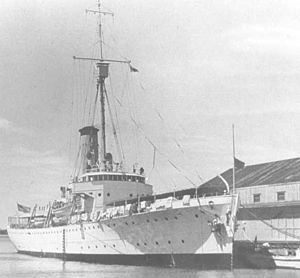Name USCGC Itasca Commissioned 12 July 1930 Launched 16 November 1929 | Decommissioned 30 May 1941 Length 76 m | |
 | ||
Builder General Engineering & Dry Dock Company, Alameda, California Fate transferred to Royal Navy under Lend-Lease | ||
Uscgc itasca 1929
The USCGC Itasca was a Lake-class cutter of the United States Coast Guard launched on 16 November 1929 and commissioned 12 July 1930. It acted as "picket ship" supporting Amelia Earhart's 1937 world flight attempt.
Contents
Career
In USCG service Itasca performed Bering Sea patrols; but is most remembered as the "picket ship" that would provide air navigation and radio links for Amelia Earhart when she made her 1937 attempt to fly around the world. Itasca, stationed at Howland Island, tried to keep in radio contact with her. However, due to a series of misunderstandings or mishaps (the details of which are still controversial), two-way radio contact was never established.
Itasca was decommissioned on lend lease to the United Kingdom where she received a name change, becoming HMS Gorleston (Y92) after the East Anglian port of Gorleston on 30 May 1941. Gorleston was equipped with Type 286M Radar after arrival in England; and was assigned to the 40th Escort Group escorting trade convoys between England and Sierra Leone with sister ships HMS Landguard and HMS Lulworth, Lend-Lease destroyer HMS Stanley and Shoreham-class sloop HMS Bideford. After escorting convoys OS 4, SL 87, OS 10, SL 93, OS 12, SL 95, OS 17, SL 100, OS 22, SL 106, OS 28, SL 112, OS 34 and SL 118 on this eastern Atlantic route, Gorleston made a trip to Iceland escorting convoys DS 33 and SD 33, and escorted convoys KMF 3, MKF 3, KMF 5, MKF 5, KMF 7 and MKF 7 between England and the Mediterranean Sea in support of Operation Torch.
Gorleston was then assigned to the 42nd Escort Group with sister ship HMS Totland, River-class frigates HMS Ness and HMS Exe, and sloops HMS Weston and HMS Folkestone escorting tanker convoys UC 1 and CU 1. Gorlestone then resumed escorting eastern Atlantic and Mediterranean convoys until refit in Wales in December 1943. After refit, Gorleston escorted eastern Mediterranean convoys from March 1944 until assigned to the Kilindini Escort Force in August 1944. Gorleston escorted Arabian Sea convoys until transferred to Colombo in June 1945. Gorleston spent the remainder of the war escorting Bay of Bengal convoys in support of Operation Zipper.
Gorleston was returned to the United States on 23 April 1946 and redesignated USCGC Itasca until scrapped in 1950.
